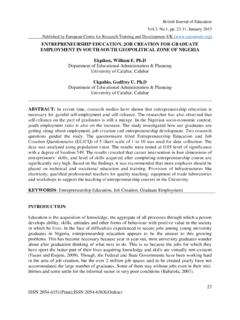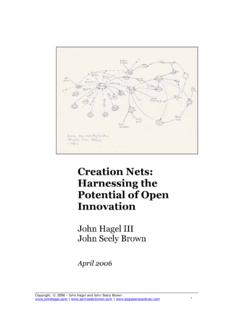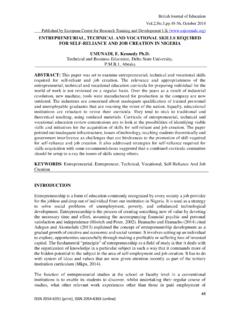Transcription of Policy Brief on Women’s Entrepreneurship - OECD.org
1 Policy Brief on Women s EntrepreneurshipThe opinions expressed and arguments employed herein do not necessarily reflect the official views of the organisation or of the governments of its member countries or those of the European document and any map included herein are without prejudice to the status of or sovereignty over any territory, to the delimitation of international frontiers and boundaries and to the name of any territory, city or Note by Turkey:The information in this document with reference to Cyprus relates to the southern part of the island.
2 There is no single authority representing both Turkish and Greek Cypriot people on the island. Turkey recognises the Turkish Republic of Northern Cyprus (TRNC). Until a lasting and equitable solution is found within the context of the United Nations, Turkey shall preserve its position concerning the Cyprus issue .2. Note by all the European Union Member States of the OECD and the European Commission:The Republic of Cyprus is recognised by all members of the United Nations with the exception of Turkey. The information in this document relates to the area under the effective control of the Government of the Republic of paper was drafted by David Halabisky under the supervision of Jonathan Potter, both of the Centre for Entrepreneurship , SMEs, Local Development and Tourism (CFE) of the Organisation for Economic Co-operation and Development (OECD).
3 An expert paper providing material for this Policy Brief was prepared for the OECD by Maria Cristina Diaz Garcia of the Universidad de Castilla-La Mancha. The data included in this paper from the Global Entrepreneurship Monitor was prepared by Jonathan Levie of the University of Strathclyde and the Global Entrepreneurship Research Association. This paper benefited from input and suggestions from Sandra Hannig of the OECD s CFE and Mariarosa Lunati of the OECD s Statistics Directorate. Comments and inputs were also received from the European Commission.
4 Key contributions were made by Guy Lejeune and Shadin Viratham of the Directorate-General for Employment, Social Affairs and Inclusion. Additional comments were received from Simone Baldassarri of the Directorate-General for Internal Market, Industry, Entrepreneurship and SMEs, and Maria Fatima Ribeiro Vilas Boas of the Directorate-General for Justice and paper is part of a series of Policy briefs on inclusive Entrepreneurship produced by the OECD Local Economic and Employment Development Programme and the European Commission Directorate General for Employment, Social Affairs and Inclusion.
5 This work is led by Jonathan Potter with David Halabisky and Sandra Hannig of the links in this publication were correct at the time the manuscript was completed. Cover photo: Dean any use or reproduction of photos which are not under OECD/European Union copyright, permission must be sought directly from the copyright holder(s).More information on the European Union is available on the internet ( ).More information on the OECD is available on the internet ( ).Luxembourg: Publications Office of the European Union, 2016 PDF ISBN 978-92-79-67995-7 KE-04-17-392-EN-N OECD/European Union, 2017 Reproduction is authorised provided the source is Brief on Women s EntrepreneurshipCONTENTSKEY MESSAGES.
6 3 WHAT IS THE GENDER GAP IN Entrepreneurship ? ..3 HOW ARE WOMEN-OWNED BUSINESSES DIFFERENT TO MEN-OWNED BUSINESSES? ..6 Women entrepreneurs tend to operate smaller often operate in different sectors than men entrepreneurs ..7 The businesses created by women entrepreneurs tend to have less growth have similar survival rates in many women work fewer hours per week, on average,.. tend to earn less than self-employed men ..10 However, Policy makers should not seek to eliminate all of these CHALLENGES DO WOMEN FACE WHEN STARTING AND GROWING BUSINESSES?
7 12 Culture and society is often unsupportive of women s tend to perceive that they lack Entrepreneurship skills ..12 Women entrepreneurs have greater difficulty accessing finance than men ..14 Women tend to have smaller and less effective entrepreneurial networks ..15 Family and tax policies can discourage female labour market participation, including Entrepreneurship ..15 HOW CAN Policy SUPPORT WOMEN ENTREPRENEURS? ..161. Promote a positive attitude through role models and ambassadors ..162. Develop Entrepreneurship skills through training courses and mentoring.
8 183. Facilitate access to finance through financial literacy and a range of financing instruments ..204. Build entrepreneurial networks and ensure linkages to mainstream infrastructures ..235. Promote work-life balance and access to social ..28 SUGGESTED FURTHER READING ..28 BIBLIOGRAPHY ..293 KEY MESSAGES Women are under-represented among the population of entrepreneurs. They tend to operate smaller and less dynamic businesses than men, and are more likely to operate in non-capital intensive sectors including personal services, which often have lower potential for generating a high and sustainable income.
9 Women entrepreneurs tend to have different motivations and intentions in Entrepreneurship than men. Some women appear to be more likely to go into self-employment to better manage their work-life balance and others start businesses to avoid the glass ceiling in employment. While it is important for individuals to have a range of choices in the labour market, women tend to have latent entrepreneurial potential that is not realised. Policy makers need to unlock this potential, recognising that women are a heterogeneous group with many differences in their motivations, intentions and projects.
10 The challenges that women identify in starting a business include discouraging social and cultural attitudes, lower levels of Entrepreneurship skills, greater difficulty in accessing start-up financing, smaller and less effective entrepreneurial networks and Policy frameworks that discourage women s Entrepreneurship . Traditional instruments such as training and grants are used to address these barriers but these approaches need to be expanded because they have not had a full reach into the population. Several new Policy approaches to supporting women in Entrepreneurship are starting to emerge.

















